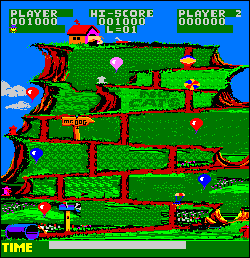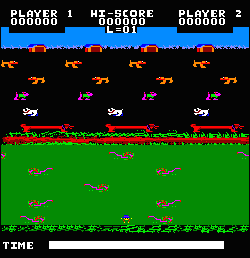 The Game: Help Mr. F. Lea get to the top in this dog-eat-dog world. Cross a treacherous yard full of lawn-mowers (and helpfully slow-moving dogs), swing from tail to tail until you’ve jumped on every dog on the screen, scale the big dog’s back and jump over his spots, and climb to the top of Dog Hollow while avoiding the dog toys and bones being thrown at you from the top of the screen. You’d better be itching to win. (Pacific Novelty, 1982)
The Game: Help Mr. F. Lea get to the top in this dog-eat-dog world. Cross a treacherous yard full of lawn-mowers (and helpfully slow-moving dogs), swing from tail to tail until you’ve jumped on every dog on the screen, scale the big dog’s back and jump over his spots, and climb to the top of Dog Hollow while avoiding the dog toys and bones being thrown at you from the top of the screen. You’d better be itching to win. (Pacific Novelty, 1982)
Memories: An oddball specimen from the dawn of the age of video game litigation, Mr. F. Lea would appear to have slipped through the cracks without attracting the wrath of the legal beagles. How that happened, we can’t even guess, for the game’s four stages strongly resemble Frogger, Donkey Kong and elements of Jungle Hunt. It’s like the hottest games in the average 1982 arcade…as played by a quirky cover band.
And if that’s an apt analogy, then this cover band is introducing its own twists; graphically and musically, Mr. F. Lea manages to improve on some of the games it copies, though in some cases the more elaborate backgrounds make it hard to tell where you are in the game (the Donkey Kong-like “Dogs’ Hollow” round being a good example of this). This doesn’t necessarily mean more fun, though – the “Dog’s Back” round is frustratingly difficult, and not the best tribute to Jungle Hunt‘s “rolling boulders” that anyone’s ever dreamed up.
 Between Mr. F. Lea and Thief, another Pacific Novelty coin-op which copied the game play of Pac-Man but tried to up the ante audiovisually, one can perhaps get a sense of one factor leading up to the early 1980s crash of the video game industry. It could be that the constant recycling of game concepts in new packaging had a lot to do with it, and even relatively short-lived operations like Pacific Novelty weren’t alone in bearing the responsibility for this (see also: Super Pac-Man, Pac & Pal, Jr. Pac-Man…). When new games offered a major innovation – Pole Position and Turbo revolutionizing the first-person racing game, or Zaxxon changing the rules of game graphics – players flocked to the arcades to try out the new games they’d hear or read so much about. But the field was also glutted with
Between Mr. F. Lea and Thief, another Pacific Novelty coin-op which copied the game play of Pac-Man but tried to up the ante audiovisually, one can perhaps get a sense of one factor leading up to the early 1980s crash of the video game industry. It could be that the constant recycling of game concepts in new packaging had a lot to do with it, and even relatively short-lived operations like Pacific Novelty weren’t alone in bearing the responsibility for this (see also: Super Pac-Man, Pac & Pal, Jr. Pac-Man…). When new games offered a major innovation – Pole Position and Turbo revolutionizing the first-person racing game, or Zaxxon changing the rules of game graphics – players flocked to the arcades to try out the new games they’d hear or read so much about. But the field was also glutted with  Mr. F. Leas aplenty – “new” games that simply repackaged old game mechanics. Even if the “new” game was fun – which Mr. F. Lea was for the most part – it brought a sense of “been there, done that” to the arcade – the one place where gamers expected to be wowed.
Mr. F. Leas aplenty – “new” games that simply repackaged old game mechanics. Even if the “new” game was fun – which Mr. F. Lea was for the most part – it brought a sense of “been there, done that” to the arcade – the one place where gamers expected to be wowed.